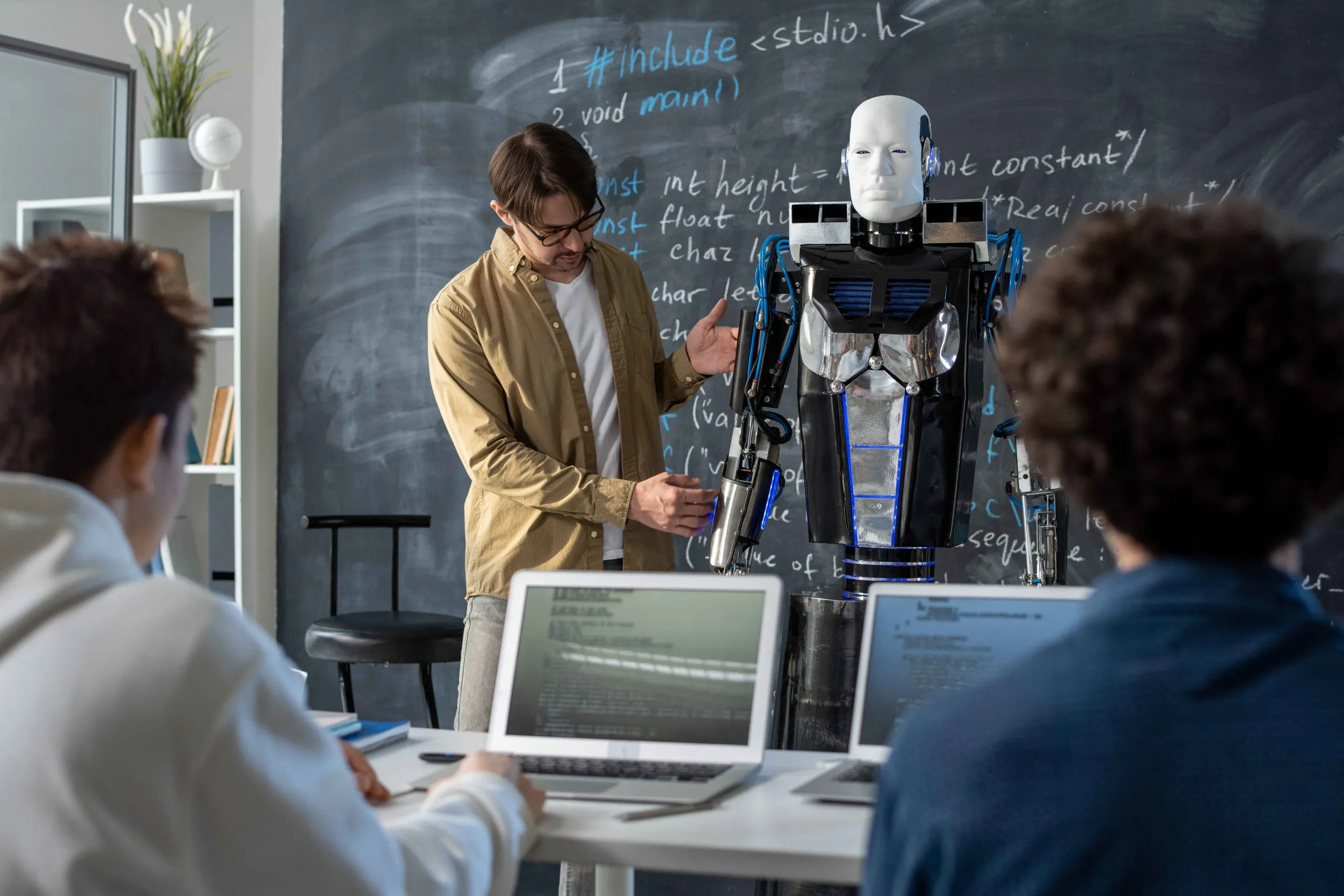Introduction to Machine Learning

Machine learning is a subfield of artificial intelligence (AI) that focuses on developing algorithms and models that enable computers to learn and make predictions or decisions without explicit programming. It is based on the idea that machines can learn from and analyze large amounts of data to identify patterns, relationships, and insights.
In machine learning, models are trained using historical data and fed into algorithms that automatically learn and improve over time. These models can then be used to predict or act on new, unseen data. Machine learning aims to enable computers to learn from experience, adapt to different scenarios, and perform tasks more accurately and efficiently.
There are different machine learning approaches, including:
- Supervised
- Unsupervised
- Reinforcement learning
Supervised learning involves training models with labeled data, where input features are associated with known output labels.
Unsupervised learning focuses on finding patterns and structures in unlabeled data. Reinforcement learning involves learning through interactions with an environment and receiving rewards or penalties based on actions taken.
Machine learning has numerous applications across various industries, including healthcare, finance, marketing, manufacturing, and more. It plays a crucial role in tasks such as:
- Image and speech recognition
- Natural language processing
- Recommendation systems
- Fraud detection and predictive analytics
By leveraging data and algorithms, machine learning enables computers to automate tasks, gain insights, and make intelligent decisions.
Machine Learning vs. Traditional Programming
Machine Learning and Traditional Programming are two approaches to solving problems and creating intelligent systems. Here’s a comparison between the two:
Traditional Programming
- Rule-based: In traditional programming, developers manually write explicit rules and instructions for the computer to follow.
- Specific solutions: Traditional programs are designed to solve specific problems or tasks based on predefined logic and rules.
- Limited adaptability: Traditional programs typically do not adapt or learn from data or experiences. They execute predetermined instructions regardless of the input or context.
Clear input-output mapping: Traditional programs require a clear mapping between input data and the expected output.
- Handcrafted features: The features and representations of the data need to be explicitly defined by the programmer.
Machine Learning:
- Data-driven: Machine learning algorithms learn patterns and make predictions based on patterns found in large datasets rather than relying on explicit rules.
- Generalization: Machine learning models are built to generalize from training data and make predictions on unseen data by identifying patterns and relationships.
- Adaptability and learning: Machine learning models can adapt and improve over time by continuously learning from new data and experiences.
- Indirect input-output mapping: Machine learning models learn the mapping between input data and output predictions without explicit programming of the rules.
- Automated feature extraction: Machine learning algorithms can automatically extract relevant features and representations from raw data, reducing the need for manual feature engineering.
In summary, traditional programming explicitly defines rules and instructions, whereas machine learning focuses on learning from data to make predictions or decisions.
Traditional programming is more suitable for well-defined tasks with clear rules, while machine learning excels in handling complex, data-driven problems where patterns need to be learned from large datasets.
Enhancing Machine Learning Models with Data
To enhance machine learning models with data, you can consider the following strategies:
- Data Preprocessing: Clean and preprocess the data before training the model. This involves handling missing values, outliers, and noise and performing feature scaling, normalization, or transformation. Proper preprocessing can improve the data quality and make it more suitable for training the model.
- Feature Engineering: Extract or create new features from the existing data to provide additional information and improve the model’s performance. This may involve combining or transforming existing features, creating interaction terms, or using domain knowledge to engineer relevant features.
- Data Augmentation: Increase the size and diversity of the training data by applying techniques such as image rotation, flipping, cropping, or adding noise. Data augmentation can help prevent overfitting and improve the model’s generalization of unseen data.
- Handling Imbalanced Data: If the dataset is imbalanced, where one class is significantly more prevalent than others, consider techniques like oversampling the minority class, under-sampling the majority class, or using advanced algorithms like SMOTE (Synthetic Minority Over-sampling Technique) to balance the dataset. This ensures that the model is not biased towards the majority class.
- Cross-Validation: Use techniques like k-fold cross-validation to assess the model’s performance on different subsets of the data. Cross-validation helps evaluate the model’s generalization ability and identify potential issues like overfitting or underfitting.
- Hyperparameter Tuning: Experiment with different hyperparameter settings to optimize the model’s performance. Hyperparameters control the behavior and performance of the model, and tuning them can help find the best configuration for a particular dataset.
- Ensemble Methods: Combine multiple models or predictions to create an ensemble model. Ensemble methods, such as bagging, boosting, or stacking, can improve the model’s accuracy, robustness, and generalization by leveraging the collective intelligence of multiple models.
- Continuous Learning: Continuously update and retrain the model with new data to adapt to changing patterns or trends. By incorporating fresh data periodically, the model can stay relevant and maintain its performance over time.
Applying these strategies can enhance the performance, robustness, and generalization ability of machine learning models, leading to more accurate predictions and better outcomes.
Ethical Considerations in Machine Learning
Ethical considerations in machine learning are crucial to ensure this technology’s responsible and fair use. Here are some key ethical considerations:
- Bias and Fairness: Machine learning models can inadvertently perpetuate biases in the training data, leading to unfair outcomes or discriminatory behavior. It is essential to carefully examine and address biases in data collection, preprocessing, and model training to ensure fairness and equal treatment for all individuals or groups.
- Transparency and Explainability: The decisions made by machine learning models should be transparent and explainable to users and stakeholders. Understanding how the model arrives at its predictions or decisions is important, allowing for accountability, trust, and the ability to detect and rectify potential errors or biases.
- Privacy and Data Protection: Machine learning relies on vast amounts of data, raising concerns about privacy and data protection. Organizations must handle data responsibly and securely, ensuring compliance with relevant regulations and obtaining informed consent when collecting and using personal data.
- Accountability and Responsibility: Clear accountability frameworks should be established to determine who is responsible for the decisions and actions of machine learning models. This includes considering the potential consequences of model deployment and ensuring appropriate safeguards and recourse mechanisms are in place.
- Algorithmic Transparency and Auditing: Machine learning algorithms should be scrutinized and audited to assess their performance, potential biases, and ethical implications. Transparency allows for external review and helps identify and rectify any issues or unintended consequences.
- Impact on Employment and Workforce: Machine learning advancements may impact employment and workforce dynamics. It is important to consider the potential effects on job displacement, job creation, and the need for upskilling or retraining programs to ensure a just transition for workers.
- Social and Environmental Impact: Machine learning applications should consider their broader social and environmental impact. This includes avoiding harm to individuals or communities, minimizing environmental footprints, and promoting positive societal outcomes.
- Informed Decision-Making: Users, stakeholders, and policymakers should have access to accurate and understandable information about machine learning systems, enabling them to make informed decisions and actively participate in shaping the technology’s development and deployment.
By addressing these ethical considerations, we can promote the responsible and beneficial use of machine learning, ensuring that it aligns with societal values, respects human rights, and contributes to a fair and inclusive future.
Real-World Applications and Benefits
Machine learning has many real-world applications and offers numerous benefits across various industries. Here are some examples:
- Healthcare: Machine learning is used for medical diagnosis, image analysis, predicting disease outcomes, drug discovery, personalized medicine, and improving healthcare operations and patient care.
- Finance: Machine learning helps in fraud detection, credit scoring, algorithmic trading, risk assessment, personalized financial recommendations, and analyzing market trends.
- Retail and E-commerce: Machine learning powers recommender systems, demand forecasting, customer segmentation, personalized marketing, inventory management, and fraud detection in online transactions.
- Manufacturing and Supply Chain: Machine learning optimizes production processes, predicts equipment failure, improves quality control, automates supply chain management, and enhances demand forecasting.
- Transportation and Logistics: Machine learning is applied in route optimization, vehicle routing, predictive maintenance of vehicles and infrastructure, fleet management, and supply chain optimization.
- Natural Language Processing (NLP): Machine learning enables sentiment analysis, text classification, language translation, chatbots, voice recognition, and speech synthesis, enhancing communication and interaction with computers.
- Autonomous Vehicles: Machine learning is crucial in self-driving cars, enabling object detection, path planning, real-time decision-making, and improving road safety.
- Energy and Utilities: Machine learning optimizes energy usage, predicts energy demand, monitors and controls power grids, improves energy efficiency and facilitates renewable energy integration.
- Marketing and Advertising: Machine learning powers targeted advertising, customer segmentation, personalized recommendations, click-through rate prediction, sentiment analysis of social media data, and campaign optimization.
- Cybersecurity: Machine learning aids in anomaly detection, network intrusion detection, malware detection, user behavior analysis, and identifying patterns of cyber threats.
The benefits of machine learning include:
- Automation: Machine learning automates repetitive tasks, saving time and reducing manual effort.
- Efficiency and Accuracy: Machine learning models can analyze large datasets quickly and accurately, leading to improved decision-making and problem-solving.
- Personalization: Machine learning enables personalized recommendations, tailored experiences, and customized solutions for users and customers.
- Insights and Predictions: Machine learning uncovers patterns, trends, and insights from data, facilitating data-driven decision-making and accurate predictions.
- Scalability: Machine learning algorithms can handle large-scale and complex datasets, making them suitable for growing data volumes.
- Continuous Improvement: Machine learning models can learn from new data and experiences, continuously improving their performance and adapting to changing environments.
Machine Learning in Healthcare

Machine learning plays a significant role in healthcare, revolutionizing the industry by enabling more accurate diagnoses, personalized treatments, and improved patient care. Here are some key roles of machine learning in healthcare:
- Medical Imaging and Diagnostics: Machine learning algorithms analyze medical images such as X-rays, MRI scans, and CT scans to aid in detecting and diagnosing diseases. It can help identify patterns and anomalies that human interpretation may miss, leading to earlier and more accurate diagnoses.
- Predictive Analytics and Risk Assessment: Machine learning models can analyze patient data, including medical history, genetics, and lifestyle factors, to predict disease risks and outcomes. This helps in identifying high-risk individuals for preventive interventions and personalized treatment plans.
- Drug Discovery and Development: Machine learning analyzes vast amounts of genomic and molecular data to identify potential drug candidates. It helps in speeding up the drug discovery process, optimizing drug efficacy, and reducing the cost and time associated with traditional drug development.
- Precision Medicine: Machine learning facilitates personalized treatment approaches by considering individual patient characteristics, genetics, and response patterns to specific therapies. It assists in tailoring treatment plans to maximize effectiveness and minimize adverse effects.
- Electronic Health Records (EHR) Analysis: Machine learning algorithms analyze electronic health records to extract valuable insights, identify patterns, and support clinical decision-making. It helps detect potential errors, improve patient safety, and enhance healthcare outcomes.
- Remote Monitoring and Predictive Maintenance: Machine learning enables remote monitoring of patients’ vital signs, allowing for early detection of abnormalities and timely interventions. It also helps predict equipment failures and optimize healthcare facility maintenance schedules.
- Natural Language Processing (NLP) and Clinical Documentation: Machine learning, combined with NLP, automates the extraction of relevant information from medical records, reducing administrative burdens and enhancing accuracy in clinical documentation.
- Healthcare Fraud Detection: Machine learning algorithms can analyze large volumes of healthcare claims data to identify patterns of fraudulent activities, enabling fraud detection and prevention measures.
Machine Learning for Natural Language Processing
Machine Learning for Natural Language Processing (NLP) applies machine learning techniques and algorithms to analyze, understand, and generate human language data. Like human language understanding, NLP focuses on enabling computers to interact with and process natural language, such as text or speech.
Machine learning plays a critical role in NLP by enabling computers to learn patterns and structures in textual data automatically. Here are some key aspects of machine learning for NLP:
- Text Classification and Sentiment Analysis: Machine learning models are trained to classify text into predefined categories or determine the sentiment expressed in a piece of text. This is useful for tasks like spam detection, sentiment analysis, topic classification, and content categorization.
- Named Entity Recognition (NER): Machine learning algorithms can identify and extract named entities from text, such as names of people, organizations, locations, and dates. NER is essential for tasks like information extraction, question answering, and text summarization.
- Part-of-Speech Tagging: Machine learning models can assign grammatical tags to words in a sentence, such as noun, verb, adjective, etc. This helps in syntactic analysis, grammar checking, and language understanding.
- Machine Translation: Machine learning techniques, such as sequence-to-sequence models or transformers, are used to translate text from one language to another automatically. Machine translation models learn to translate by training on large bilingual or multilingual datasets.
- Text Generation: Machine learning models can generate human-like text based on training on large corpora of text data. This is used in chatbots, virtual assistants, and content-generation applications.
- Question Answering: Machine learning models can be trained to understand questions and provide accurate answers based on a given context or knowledge base. This is applied in chatbots, information retrieval systems, and virtual assistants.
- Language Modeling: Machine learning algorithms can build language models that capture word sequences’ statistical patterns and probabilities. Language models are used for speech recognition, auto-complete, and text generation tasks.
Machine learning techniques in NLP involve training models on large labeled datasets, applying algorithms like neural networks, decision trees, or support vector machines, and fine-tuning them to optimize performance.
Machine Learning in Image Recognition

Machine Learning in Image Recognition refers to applying machine learning techniques to analyze and understand visual data, such as images or videos. It involves training machine learning models to recognize and classify objects, scenes, patterns, or features within images.
Here are some key aspects of machine learning in image recognition:
- Training Data: Machine learning models for image recognition require large labeled datasets for training. These datasets consist of images along with corresponding labels or annotations that specify the objects or features present in the images.
- Feature Extraction: Machine learning models extract relevant features from images to capture their distinguishing characteristics. These features may include edges, shapes, textures, colors, or higher-level representations learned through convolutional neural networks (CNNs) or other deep learning architectures.
- Model Training: Machine learning models, such as CNNs, are trained on the labeled dataset to learn the mapping between input images and their corresponding labels. The models adjust their internal parameters through optimization to minimize prediction errors.
- Object Detection: Machine learning models can be trained to detect and localize multiple objects within an image. Object detection algorithms identify the bounding boxes and class labels for various objects in the image.
- Classification and Recognition: Machine learning models classify images into predefined categories or labels. This enables image recognition, where the model predicts the most likely label or class for a given input image. For example, it can identify whether an image contains a dog, cat, car, or other object of interest.
- Transfer Learning: It is a technique in which pre-trained models trained on large-scale image datasets, like ImageNet, are utilized as a starting point for training new models on specific image recognition tasks. This approach helps leverage the knowledge learned from a vast amount of data and reduces the need for extensive training on limited datasets.
- Fine-tuning: It involves adjusting the pre-trained models to adapt them to specific image recognition tasks or domains. By further training the models on domain-specific data, they can specialize in recognizing specific objects or features relevant to the target application.
Machine learning enables computers to analyze and interpret visual information, leading to advancements in various fields and enhancing our ability to understand and interact with the visual world.










